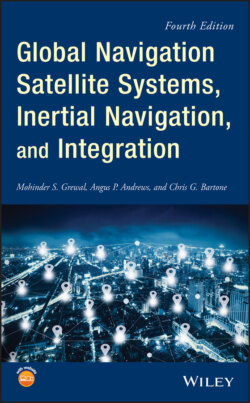Читать книгу Global Navigation Satellite Systems, Inertial Navigation, and Integration - Mohinder S. Grewal - Страница 101
3.4.1 Geoid Models
ОглавлениеCarl Friedrich Gauss introduced the idea of a geoid in 1828 as the “mathematical figure of the Earth,” defining its shape as that of a reference equipotential surface (e.g. mean sea level), and defining locations in the near‐Earth environment in terms of longitude, latitude and altitude with respect to that geoid shape.
Geoid models began as oblate spheroids – something predicted by Isaac Newton as the real shape of the Earth – with the Earth's center of mass at its center, the Earth rotation axis along its short axis, and the Airy Transit Circle at the Royal Observatory in Greenwich at its prime meridian.
Later refinements included undulations of the equipotential surface above and below the reference ellipsoid, represented in terms of spherical harmonics. That basic concept is still in use today, and it is used for GNSS navigation. Geoid models are also used for inertial navigation. Besides providing a common grid solution for position, geoids also provide models for the near‐Earth gravitational field.
There are different geoids for different purposes. Those used for surveying generally include some model for the local vertical direction as a function of location, because the local vertical is used as a reference direction in surveying. Those used in hydrology need to include something equivalent to gravitational potential. Those used in inertial navigation need to include the local gravitational acceleration magnitude and direction.
There have been many geoid models over the years, and multiple international efforts to establish a common one. The WGS84 reference geoid was established by the 1984 World Geodetic Survey, and it has become widely used in GNSS and inertial navigation.
